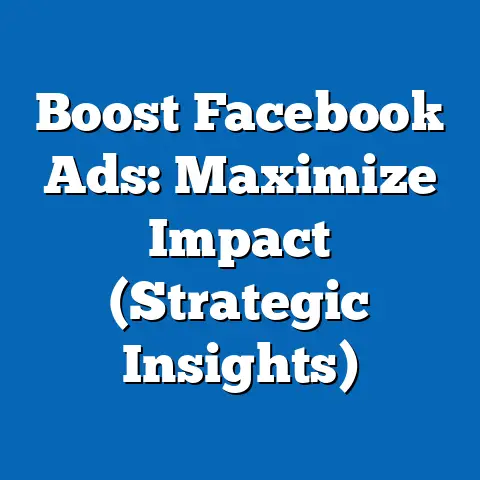Unlocking Cult Gym Success (Insider fb ad Strategies)
In recent years, the fitness industry has witnessed the emergence of “cult gyms”—fitness communities that transcend traditional workout spaces by fostering intense loyalty, shared identity, and transformative experiences among their members. These gyms, such as CrossFit boxes, SoulCycle studios, and boutique fitness brands like Orangetheory Fitness, have redefined what it means to belong to a fitness community, turning exercise into a lifestyle and a social movement.
At the heart of their success lies the concept of transformation—both physical and emotional. This article explores how cult gyms leverage transformation as a core value, examines the historical and societal factors that have fueled their rise, and delves into the insider strategies behind their highly effective Facebook advertising campaigns. By analyzing data, case studies, and expert insights, we aim to uncover how these gyms build fervent followings and what their success reveals about modern consumer behavior, generational dynamics, and digital marketing trends.
Section 1: Transformation as the Core of Cult Gym Appeal
Defining Transformation in the Context of Cult Gyms
Transformation, in the context of cult gyms, refers to a holistic change that encompasses physical fitness, mental resilience, and social connection. Unlike traditional gyms that focus primarily on individual goals like weight loss or muscle gain, cult gyms position themselves as catalysts for life-altering journeys.
Members often describe their experiences as “life-changing,” citing not just improved health but also newfound confidence, a sense of belonging, and even shifts in personal values. This multi-dimensional transformation is a key differentiator, setting cult gyms apart from conventional fitness centers and creating a powerful emotional hook for marketing.
Key Characteristics of Transformation in Cult Gyms
Several defining characteristics underpin the transformative appeal of cult gyms. First, they emphasize community over competition, fostering environments where members support one another through shared struggles and triumphs.
Second, they incorporate high-intensity, group-based workouts that push individuals beyond their perceived limits, creating a sense of achievement that reinforces personal growth. Finally, many cult gyms adopt a storytelling approach, encouraging members to share their “before and after” narratives—both in person and online—which amplifies the perception of transformation as an attainable, collective experience.
Historical Context: Why Transformation Resonates Now
The rise of cult gyms and their focus on transformation can be traced to broader societal shifts over the past few decades. The late 20th and early 21st centuries saw a growing emphasis on individualism, self-improvement, and personal branding, particularly among Millennials and Gen Z, who came of age during periods of economic uncertainty and digital disruption.
The 2008 financial crisis, for instance, left many young adults questioning traditional paths to success, prompting a turn toward self-actualization through fitness and wellness. Meanwhile, the advent of social media platforms like Instagram and Facebook provided a stage for showcasing personal transformations, making fitness a visible marker of identity and resilience.
Additionally, the decline of traditional community structures—such as religious institutions or local clubs—created a vacuum for new forms of belonging. Cult gyms stepped into this space, offering a modern “tribe” where individuals could find purpose and connection through shared physical challenges.
Societal Implications of Transformation-Driven Fitness
The emphasis on transformation in cult gyms reflects broader cultural trends toward experiential consumption and the prioritization of wellness. Unlike material purchases, experiences like a grueling workout or a supportive fitness class provide lasting emotional value, aligning with the values of younger generations who often prioritize “living their best life” over accumulating possessions.
However, this focus on transformation also raises questions about accessibility and inclusivity. Cult gyms often come with high membership fees, limiting participation to those with disposable income and potentially reinforcing socioeconomic divides. Moreover, the intense focus on personal change can sometimes veer into pressure or exclusion, alienating individuals who may not fit the mold of the “transformed” ideal.
Section 2: The Generational Dynamics of Cult Gyms
Millennials and Gen Z: The Core Audience for Transformation
Cult gyms have found particular resonance with Millennials (born 1981–1996) and Gen Z (born 1997–2012), two generations shaped by distinct yet overlapping cultural and economic forces. Millennials, often characterized as seekers of meaning in the wake of economic instability, gravitate toward cult gyms for their promise of self-improvement and community.
Gen Z, on the other hand, brings a digital-native perspective, valuing authenticity and social impact. They are drawn to cult gyms that align with their values—such as sustainability or body positivity—and that offer Instagrammable moments to share online.
Contrasting with Older Generations
While Millennials and Gen Z dominate the cult gym demographic, older generations like Gen X (born 1965–1980) and Baby Boomers (born 1946–1964) engage with these spaces differently. Gen Xers, often juggling family and career responsibilities, may view cult gyms as a way to reclaim personal time or combat midlife health concerns, though they are less likely to embrace the social media aspect of transformation.
Baby Boomers, meanwhile, may prioritize functional fitness over intense transformation narratives, seeking programs that support aging gracefully rather than dramatic physical change. These generational differences highlight the need for cult gyms to tailor their messaging and offerings to diverse audiences.
Nuances Within Generational Groups
It’s critical to avoid overgeneralization when discussing generational trends in fitness. Not all Millennials or Gen Zers are drawn to cult gyms—many prefer solo workouts or budget-friendly options due to financial constraints.
Similarly, cultural and geographic factors play a significant role in engagement. Urban dwellers, for instance, are more likely to join cult gyms due to proximity and social trends, while rural individuals may lack access or interest in such communities. Recognizing this diversity ensures a more accurate understanding of cult gym appeal.
Section 3: The Role of Technology and Digital Marketing in Cult Gym Success
Social Media as a Catalyst for Transformation Stories
Technology, particularly social media, has been instrumental in amplifying the transformation narrative of cult gyms. Platforms like Instagram and Facebook allow members to document their fitness journeys, creating a feedback loop where personal stories inspire others to join.
Cult gyms capitalize on this by encouraging user-generated content (UGC), such as before-and-after photos or workout videos, which serve as authentic testimonials. According to a 2022 study by Stackla, 79% of consumers say UGC highly impacts their purchasing decisions, underscoring the power of community-driven content in fitness marketing.
The Evolution of Facebook Advertising for Cult Gyms
While Instagram often takes center stage for visual storytelling, Facebook remains a powerhouse for targeted advertising, especially for cult gyms aiming to reach specific demographics. Facebook’s robust ad platform allows gyms to segment audiences by age, location, interests, and behaviors, ensuring that transformation-focused messages reach the right people.
Over the past decade, cult gyms have shifted from broad, generic ads to hyper-personalized campaigns that highlight individual success stories and community values. This evolution mirrors broader digital marketing trends, where emotional resonance and authenticity outperform traditional sales pitches.
Section 4: Insider Facebook Ad Strategies for Cult Gym Success
Strategy 1: Leveraging Emotional Storytelling
One of the most effective Facebook ad strategies employed by cult gyms is emotional storytelling. Ads often feature real members sharing their transformation journeys, complete with raw, unfiltered footage of sweat-soaked workouts and tearful breakthroughs.
These narratives tap into universal desires for growth and belonging, making viewers feel that they, too, can achieve similar results. For example, CrossFit has run successful campaigns showcasing athletes of all ages and abilities overcoming personal challenges, reinforcing the message that transformation is accessible to everyone.
Strategy 2: Targeting Niche Communities with Lookalike Audiences
Cult gyms often use Facebook’s “Lookalike Audiences” feature to target users who resemble their existing members in terms of interests and demographics. By analyzing data from current members—such as their engagement with fitness content or participation in local events—gyms can identify potential recruits who are likely to value transformation and community.
This strategy is particularly effective for boutique gyms with limited budgets, as it maximizes return on investment by focusing on high-potential leads. A 2021 report by Hootsuite found that lookalike audiences can increase ad conversion rates by up to 30%, highlighting their value in niche marketing.
Strategy 3: Offering Free Trials and Challenges
Another insider tactic is using Facebook ads to promote free trials or short-term fitness challenges, which lower the barrier to entry for curious prospects. These campaigns often frame the trial as the first step toward transformation, with headlines like “Change Your Life in 7 Days” or “Join Our Tribe for Free.”
By combining urgency (limited-time offers) with the promise of immediate results, cult gyms create a compelling call to action. Data from WordStream indicates that ads with time-sensitive offers can boost click-through rates by 20–25%, demonstrating the effectiveness of this approach.
Strategy 4: Retargeting and Community Building
Retargeting—showing ads to users who have previously interacted with a gym’s content—is a cornerstone of cult gym advertising on Facebook. For instance, someone who watched a transformation video but didn’t sign up might later see an ad offering a discount or inviting them to a community event.
This strategy not only recaptures lost leads but also reinforces the sense of community by emphasizing that “everyone is welcome.” Retargeting campaigns often achieve conversion rates 2–3 times higher than standard ads, according to a 2020 study by AdRoll, making them a critical tool for growth.
Strategy 5: Highlighting Social Proof and Reviews
Social proof, such as member testimonials and star ratings, plays a significant role in cult gym ads. Facebook’s ad platform allows businesses to showcase reviews directly in their campaigns, building trust with potential members who may be skeptical of transformation claims.
Gyms like SoulCycle often include snippets of glowing feedback in their ads, paired with images of packed classes to convey energy and camaraderie. This tactic aligns with consumer psychology—Nielsen reports that 92% of people trust recommendations from peers over traditional advertising.
Section 5: Economic and Cultural Factors Driving Cult Gym Ad Success
Economic Trends Supporting Premium Fitness Experiences
Economically, the rise of cult gyms coincides with a growing willingness to spend on health and wellness, particularly among higher-income Millennials and Gen Zers. Despite economic challenges like student debt or housing costs, many in these cohorts view fitness memberships as non-negotiable investments in their well-being.
A 2023 report by McKinsey found that the global wellness industry is valued at over $1.5 trillion, with boutique fitness studios capturing a significant share. This trend supports the premium pricing of cult gyms and justifies their heavy investment in targeted advertising.
Cultural Shifts Toward Authenticity and Connection
Culturally, the success of transformation-focused ads reflects a broader desire for authenticity and human connection in an increasingly digital world. As social media amplifies comparison and isolation, cult gyms offer a counterbalance by promoting real-world relationships and tangible results.
Their Facebook ads often emphasize these elements, using candid visuals and relatable language to stand out in a crowded digital landscape. This alignment with cultural values enhances ad effectiveness and strengthens member loyalty.
Section 6: Implications for Society, Workplaces, and Marketing
Societal Impact: Redefining Health and Community
The success of cult gyms and their transformation narratives has reshaped societal perceptions of health, moving beyond aesthetics to encompass mental and social well-being. This shift encourages a more holistic approach to fitness but also raises concerns about the commercialization of self-improvement and the potential for burnout in high-intensity environments.
Additionally, cult gyms have redefined community in the digital age, offering a blueprint for other industries seeking to build loyal followings. Their model of blending physical and virtual engagement could influence how schools, workplaces, and even political movements foster connection.
Workplace Relevance: Fitness as a Corporate Benefit
In the workplace, the popularity of cult gyms has prompted companies to incorporate fitness benefits into employee wellness programs. Partnerships with brands like Orangetheory or CrossFit are becoming common, as employers recognize the link between physical transformation and improved productivity or morale.
Facebook ads targeting corporate audiences—such as HR managers or team leaders—often highlight these benefits, positioning cult gyms as partners in employee retention. This trend underscores the broader societal integration of fitness into daily life.
Marketing Lessons: The Power of Emotional Resonance
For marketers, cult gym ad strategies offer valuable lessons in emotional storytelling and community building. By prioritizing transformation over transactional messaging, these gyms demonstrate how brands can create lasting connections with consumers.
Their use of data-driven targeting and retargeting also highlights the importance of precision in digital advertising. As competition in the fitness industry grows, these insider strategies could inspire innovation across sectors, from education to retail.
Section 7: Challenges and Criticisms of Cult Gym Marketing
Accessibility and Equity Concerns
Despite their success, cult gyms face criticism for their high costs and potential to exclude lower-income individuals. Facebook ads, while effective at reaching target audiences, often fail to address these equity concerns, focusing instead on aspirational lifestyles that may feel unattainable to many.
This exclusivity risks alienating diverse populations and perpetuating stereotypes about who “belongs” in fitness spaces. Addressing these challenges will require more inclusive messaging and pricing models.
Risk of Overpromising Transformation
Another critique is the risk of overpromising transformation in ads, which can lead to disappointment or disillusionment among members who don’t achieve expected results. While emotional storytelling is powerful, it must be balanced with realistic expectations to maintain trust.
Some cult gyms have faced backlash for promoting unsustainable workout regimens or fostering overly competitive environments. Transparent advertising that acknowledges the challenges of transformation can help mitigate these issues.
Section 8: Forward-Looking Insights and Uncertainties
The Future of Cult Gyms in a Digital-First World
Looking ahead, cult gyms are likely to deepen their integration of technology, using virtual reality workouts or AI-driven personalization to enhance transformation experiences. Facebook and other platforms will remain key channels for reaching new members, though evolving privacy regulations may complicate targeted advertising.
Hybrid models—combining in-person and online fitness—could also expand access, addressing some equity concerns while maintaining community focus. However, the long-term sustainability of high-intensity transformation narratives remains uncertain, as consumer preferences may shift toward gentler, mindfulness-based practices.
Broader Implications for Generational Engagement
As Gen Z continues to shape cultural trends, cult gyms may need to adapt their messaging to emphasize social impact and sustainability over individual achievement. Meanwhile, engaging aging Millennials and Gen Xers will require tailored offerings that balance transformation with practicality.
The interplay of generational values, technology, and economic factors will shape the next chapter of cult gym success. While their current model has proven effective, flexibility and innovation will be essential to staying relevant.
Conclusion: Transformation as a Cultural and Marketing Force
Cult gyms have unlocked remarkable success by centering transformation in their ethos and marketing, particularly through sophisticated Facebook ad strategies. By tapping into universal desires for growth, community, and purpose, they have built loyal followings among Millennials, Gen Z, and beyond, reshaping how society views fitness and belonging.
Their insider tactics—emotional storytelling, lookalike audiences, free trials, retargeting, and social proof—offer a masterclass in digital marketing, with implications far beyond the fitness industry. Yet, challenges like accessibility and the risk of overpromising highlight the need for balance and inclusivity in their approach.
As we look to the future, the story of cult gyms serves as a reminder of the power of transformation—not just in fitness, but in how brands connect with consumers on a deeply human level. While uncertainties remain, their ability to adapt to generational shifts and technological advancements will determine whether their cultural impact endures.






